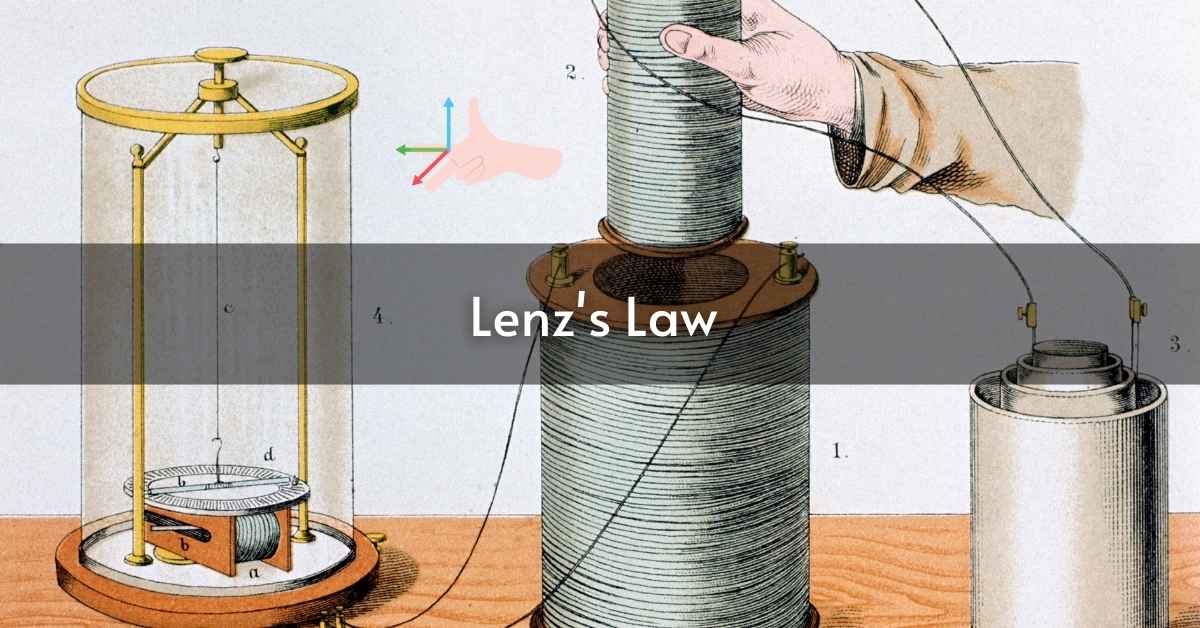Electrolysis is a fundamental chemical reaction in which electrical energy can be employed to cause a reaction that would not be induced otherwise. The process functions very fundamentally in electroplating and the extraction of metals. It is thus very essential that chemistry students, especially at advanced levels, be familiar with the laws of electrolysis. There are two significant laws formulated by the great scientist Michael Faraday that explain the process of electrolysis in detail. These laws are called Faraday’s First and Second Laws of Electrolysis. Therefore, it enables us to analyze how electrical energy is converted into chemical energy.
What is Lenz’s Law?
Lenz’s Law states that the direction of an induced current opposes the changing magnetic flux which caused it. Heinrich Lenz formulated this concept in 1834, and it plays a vital role in electromagnetic induction. Upon experiencing a variation in magnetic flux, a conductor, such as a wire, induces a certain amount of electromotive force (EMF) along with the production of current.
The induced current generates its own magnetic field in a direction opposite that of the changing magnetic flux. Thus, this law shows how no fundamental principle of energy conservation is violated: this process cannot create or destroy energy.
Key Concepts
To understand Lenz’s Law, you have to learn a couple of basic concepts about magnetic induction and magnetic flux:
- Magnetic Induction: This happens when a changing magnetic field induces an electromotive force EMF in a conductor. For example, when moving a magnet across the space near a wire, you could induce a voltage. If the circuit were closed, then the induced voltage would generate current.
- Magnetic Flux: It is that number of magnetic field lines that pass through a given area. A time-varying magnetic flux through a circuit induces current.
The Magnetic Induction Process
The changing magnetic field due to a moving permanent magnet or electromagnet induces a current in a conductor. This induced current produces a magnetic field opposing the motion of the magnet. There is a very clear illustration of this interaction which we observe in many devices such as generators and transformers.
For example, when you take a magnet near to a coil, the direction in which the induced current flows is against the approach of the magnet. Now when you pull the magnet away, the induced current would change directions so as to oppose the decrease in the magnetic flux.
Lenz’s Law and Conservation of Energy
Lenz’s law helps us follow the conservation of energy. When a current flows due to Lenz’s law, it creates a magnetic field that goes against the magnetic field that caused it. This rule comes from the law of conservation of energy.
You might ask why this is important. Let’s think about what would happen if it weren’t true.
If the magnetic field from the induced current matched the original field, they would combine into a stronger magnetic field.
This stronger field would then create a new current in the conductor that is twice as strong as the original current.
That new current would generate yet another magnetic field, creating another current, and so on.
If Lenz’s law didn’t require the induced current to create an opposing magnetic field, we would have an endless loop of energy creation, which would break the conservation of energy.
Lenz’s law also follows Newton’s third law of motion, which states that for every action, there is an equal and opposite reaction.
If the induced current creates a magnetic field that opposes the original field, it can resist changes in that magnetic field. This is in line with Newton’s third law.
Applications of Lenz’s Law
Lenz’s law has many important applications:
Lenz’s law explains how magnetic energy is stored in an inductor. Now, if you connect the emf source to an inductor, then, obviously, the circuit current starts to rise. Such rising current is opposed by the back emf induced. So, if the external emf is applied against such opposition, it allows the current to start or rise. The work done may be stored within the inductor and recovered later once the external emf source is removed.
- Induced emf: This law states that the induced emf and the change in magnetic flux are oppositely signed. This relationship helps in understanding the sign selection used in the law of Faraday’s induction.
- Electric Generators: This law even applies to electric generators. When a current flows in a generator, the direction opposes the rotation of the generator. Hence, it takes more mechanical energy to keep on turning. It even gives back emf when used with electric motors.
- Other Uses: Lenz’s law can be exploited in electromagnetic braking systems and induction cooktops.
Real-World Implications of Lenz’s Law
Lenz’s Law impacts engineering and technology in real life. Engineers can design efficient electrical systems and devices if they know how it works. A simple application in the field would be the engineers calculating the opposing currents within inductive loads, as these are crucial in terms of affecting the efficiency and performance of electrical circuits.
It also impacts the environment, and this in turn has its effects on renewable energy technologies. Similar to hydroelectric generators, the working principles of wind turbines follow electromagnetic induction. Optimizing these systems will increase the number of sustainable solutions for generating energy.
Conclusion
Lenz’s Law is an important idea in electromagnetism. It reveals how induced currents work and even shows us the conservation of energy is always present. It is a very vital principle used in quite several industries, so engineers and scientists consider it very essential. By learning about Lenz’s Law, one can better understand electromagnetic systems and their implications in modern technology.
FAQs
How is Lenz’s law related to the law of conservation of energy?
Lenz’s law is in compliance with the law of conservation of energy. From the explanation above, it states that the induced current always opposes the cause that tends to create it. Thus, extra work occurs against the opposing force, results in alterations in magnetic flux, and induces a current in the circuit. This additional work is known as electrical energy, thus verifying the law of conservation of energy.
What is the difference between Lenz’s law and Faraday’s law?
Lenz’s law speaks concerning energy conservation in electromagnetic induction, while Faraday’s law accounts for the description of the electromagnetic force that arises.
Why does Lenz’s law matter?
Lenz’s law helps us to find the direction of the induced current.
What does a negative sign in Lenz’s law represent?
The minus sign in in the law tells us that the induced emf in the coil acts in a direction opposite to that of the magnetic flux linked to the coil.
Where do we apply Lenz’s law?
We apply this law to describe why electromagnetic circuits obey the postulates of energy conservation and Newton’s third law.
Read More – Faraday’s Laws of Electrolysis: First and Second Law











